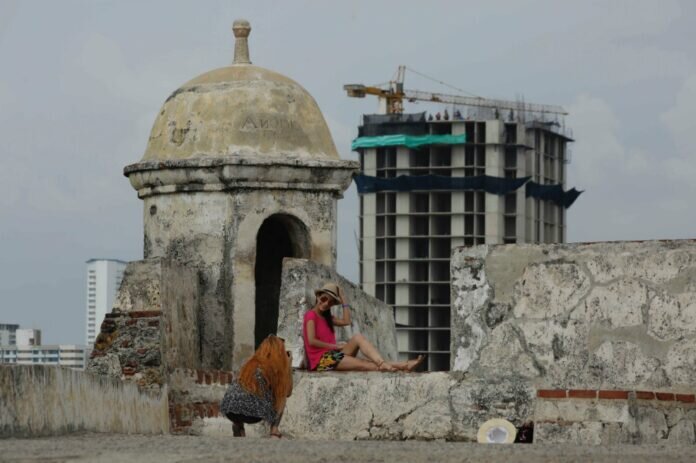C… is for Corrupción
Corruption in Cartagena.
— noun —
cause to act dishonestly in return for money or personal gain.
"there is a continuing fear of firms corrupting politicians in the search for contracts"
change or debase by making errors or unintentional alterations.
"a backup copy will be needed if the original copy becomes corrupted"
In Cartagena, everyone is corrupt. It’s almost impossible not to be when corruption in Cartagena has become so deeply ingrained in everyday life and when the city’s leaders have established corrupt practices as the norm for decades.
Cutting the line at the bank thanks to your friends or a person paid to sit in a queue for you, paying bribes to traffic cops to avoid getting a ticket, bribes by foreigners paid to police when caught with drugs, police that give the drugs back after being bribed, or residents paying public servants to help speed up a building permit, or to avoid the closure of a business due to noise pollution infringements. In Cartagena, everyone’s at it.
Then there’s the “other level” corruption in Cartagena: the billions of dollars stolen in the construction of the refinery, the “taxation” of hospitals and schools by corrupt officials, dead people claiming pensions, the payments of millions of dollars to little league baseball competitions with 29 followers on Facebook.
William Dau, the anti-corruption activist turned surprise mayor in 2020, estimated that before he arrived in city hall, 70% of the city’s public spending was being stolen every year, the equivalent of USD$312 million, and only 2% of cases investigating corruption ever ended in conviction. Read that again.
His election with 114,000 votes shows that at least 10% of the city has grown tired of the endless pilfering.
Alas for many others corruption fits all too neatly with the lifestyle to which so many people in this town have become accustomed. How else can so many people afford a four-wheel-drive vehicle worth more than a house on the wages being earned in the average Cartagena business? How else can you build a hotel in the islands without a concession? How else can you build cheap social housing in a tower block adjacent to the San Felipe Castle?
The Acuarela building, a social housing project, which now threatens Cartagena’s UNESCO World Heritage Site status is perhaps the most obvious symbol of corruption in Cartagena. A monument to the city’s indifference to the all-pervasive culture of corruption. Built-in plain sight under everybody’s noses without anyone’s apparent approval, the 32-story building stands as a testimony to the city’s incapacity to control the most destructive of its corrupt impulses.
It is no coincidence that this city, where pirates and corsairs became notorious, has been the cradle of the largest embezzlement case in Colombian history.
Some assure that the corruption gene is now as deeply ingrained in Colombian and Cartagena culture as coconut rice and fried fish. Ironically, this so-called “Malicia Indigena”, (indigenous badness) doesn't stretch back to Colombia’s indigenous tribes at all.
The inhabitants that pre-date the creation of Colombia, which previously inhabited the area now known as Cartagena, knew very little about corruption. It was their conquerors that imported the practice and expert proponents from Europe.
Pedro de Heredia, founder of Cartagena in 1503 and responsible for the genocide of the Karibes and Kalamaris natives, is the best example.
Maybe past ghosts condemned this town to live amid hunger and misery caused by the looting of the public treasury. Maybe not. Maybe the families that have monopolized power since have served to make things worse over the centuries.
While Cartagena’s abjectly poor population watched on nihilistically believing that they could do nothing to change the status quo.
Worst of all, is that the story always ends badly for those who, like Maribel Pájaro, survive every day on COP$2000, the equivalent of 50¢.
How can anyone be able to feed a family of six with this amount of money?
A plantain, two eggs, and a little oil complete Maribel's shopping list. With this, she will have to feed the three children who live in his house in the El Pozón neighborhood, located in the southwest of Cartagena.
She and the adults who make up the family nucleus will not eat today unless they are able to scrape together enough recycled plastic to add to their shared economy.
This Is Cartagena, the ancient pearl of the Spanish crown recognized in the world as “paradise found”. Home to the most expensive real estate in South America. Many of these houses belong to the city’s corrupt political class and their superiors. Soaking up the city’s riches and leaving scraps for those homes where the hunger seemingly never ends.
Even before the pandemic, 29% of Cartagena's population lived in poverty and 5.5% in extreme poverty - which means earning less than $2 per day. These numbers have increased inexorably with the pandemic and the shuttering of tourist businesses, responsible for 1 in 3 jobs in Cartagena.
Of the 13 major cities in Colombia, only Quibdo, the capital of Choco, has a lower per capita average income than Cartagena.
The administrative and interim journeys of the last decade, and the historical legacy of looting, delayed a city that, despite contributing 70.3% of the departmental GDP - about 35.13 trillion pesos for the national GDP - presents high multidimensional poverty indices.
Only to mention something, in Cartagena, access to drinking water is one of the lowest among the thirteen main cities in the country.
The island and rural population that does not have an aqueduct are 29,215, 5% of the people in the urban area do not have access to this service, according to data from polling watchdog Cartagena Como Vamos.
Welcome to Cartagena.
Worth Exploring:
The anti-corruption activist turned mayor cleaning up Cartagena’s act.
The broken social elevator
Published: 05.07.2021
Text by: Emilio Cabarcas
Bio of Emilio Cabarcas
Photos: El Espectador
Corrupto.
Something about the video
Video by: La Pulla








